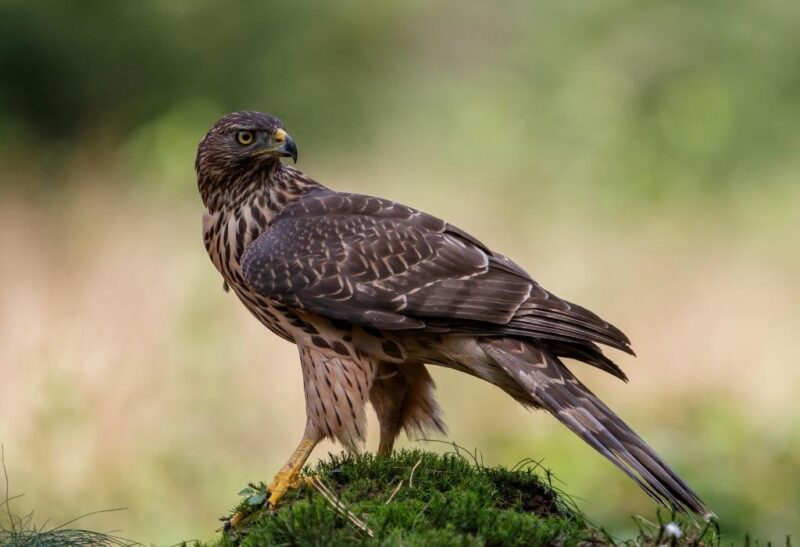Hawks are birds of prey that generally have broad wings and tails that soar often without even flapping their wings.
In Indiana, they occupy virtually every type of habitat ranging from grasslands and fields to wetlands and forests. They’re also found in urban and suburban areas such as parks, roadsides, and cemeteries.
In Indiana you can find the Cooper’s hawk, Northern Harrier, Rough-legged hawk, Swainson’s hawk, Broad Winged hawk, Sharp-shinned hawk, Northern Goshawk, Red-shouldered Goshawk, Red-tailed hawk, and Ferruginous hawk in Indiana.
If you want to know more about these hawks, what they look like, how long they live, their physical attributes, food preferences, place of origin, and defining characteristics, read further this article!
Table of Contents
How to Identify a Hawk?
You can identify them by subgroups and their distinct characteristics. There are two subgroups of hawks under the family of Accipitridae in Indiana: the accipiters and buteos.
Accipiters are generally agile woodland hawks characterized by their short, rounded wings and long tails, while buteos usually soar high in the sky and have broad, band-patterned tails and rounded wings.
The Northern Harrier, which is the only hawk under the genus Circus in Indiana, is characterized by its long wings and narrow tails. They’re also known for preferring to fly low on the ground compared to other hawks in the state.
All birds of prey, including hawks, show reverse sexual size dimorphism. In other words, female hawks are relatively larger compared to males.
10 Types of Hawks in Indiana
Cooper’s Hawk
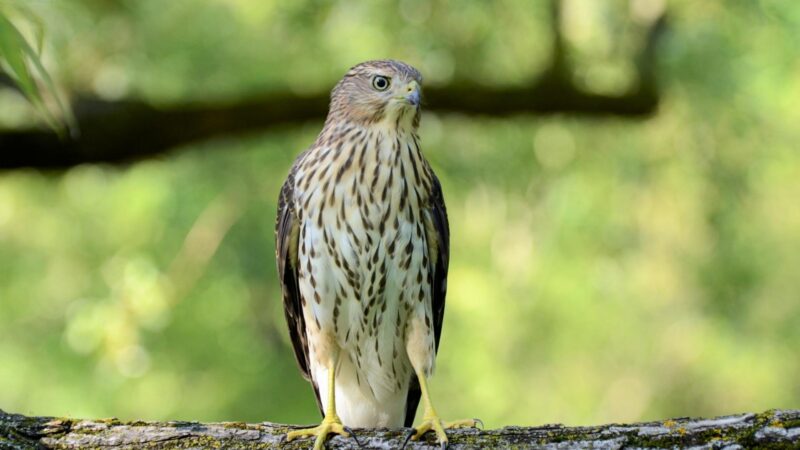
A woodland raptor capable of flying steadily at high speeds through forested areas and vegetation, Cooper’s hawks are highly visible during their migratory season generally beginning in late August.
- Scientific Name: Accipiter cooperii
- Appearance: They are medium-sized birds with hooked beaks, long and lean bodies, short rounded wings, and long tails.
- Color: Upper parts are gray with a dark cap on the head, underparts are reddish brown, backs are blue-gray, and tails have patterned dark bands with a white tip.
- Lifespan: 1.3 to 12 years (wild)
- Habitat: Mixed, deciduous, and coniferous forests, open woodland areas, and wooded suburban areas
- Length: 35 to 50 centimeters
- Weight: 280 to 566 grams
- Wingspan: 75 to 94 centimeters
- Diet: Small mammals (particularly squirrels and chipmunks), birds (bobwhites, doves, robins, starlings, pigeons), occasionally reptiles and amphibians
- Place Of Origin: North America
- Characteristics: They are diurnal, migratory, and solitary birds who prefer vocalizations as a means of communication and have keen eyesight used to locate prey.
Northern Harrier
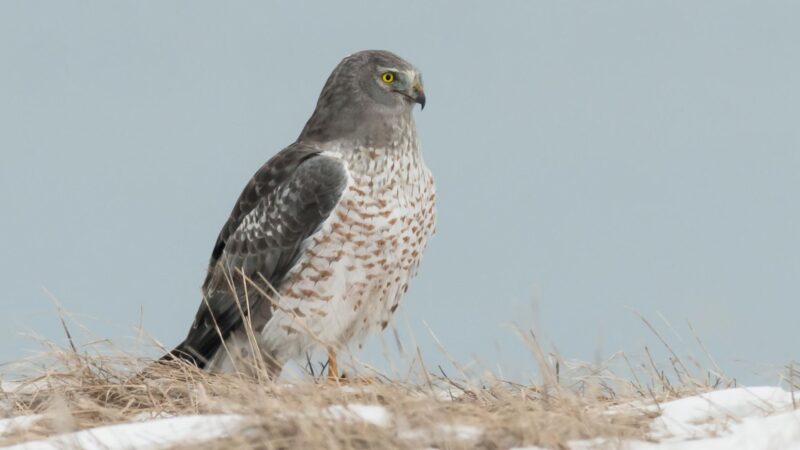
Northern Harriers also referred to as Hen Harriers due to their tendency of preying on fowl, are slow-flying raptors that prefer flying low over the ground as well as gliding and occasionally hovering. They also hop and walk on the ground to collect prey and assemble nesting materials.
- Scientific Name: Circus cyaneus
- Appearance: They have medium-sized with slender bodies, owl-shaped faces, narrowly rounded tails, long and broad wings, and small but sharply hooked bills.
- Color: Females have brown bodies with black-banded patterns on their tails and white undersides with brown streaks. Males have gray bodies with white underparts, black-tipped wings, and black-banded patterns on their tails. Both have yellow eyes.
- Lifespan: 1.4 to 16.2 years (wild)
- Habitat: Undisturbed open areas such as wetlands (mostly marshes), grasslands, and agricultural areas with low and dense vegetation
- Length: 41 to 50 centimeters
- Weight: 290 to 750 grams
- Wingspan: 97 to 122 centimeters
- Diet: Primarily small mammals such as mice, rabbits, shrews, songbirds, waterfowl, snakes, and frogs
- Place Of Origin: North America
- Characteristics: Diurnal and migratory birds. Unlike most hawks, they rely on their sense of hearing when locating and capturing prey.
Rough-Legged Hawk
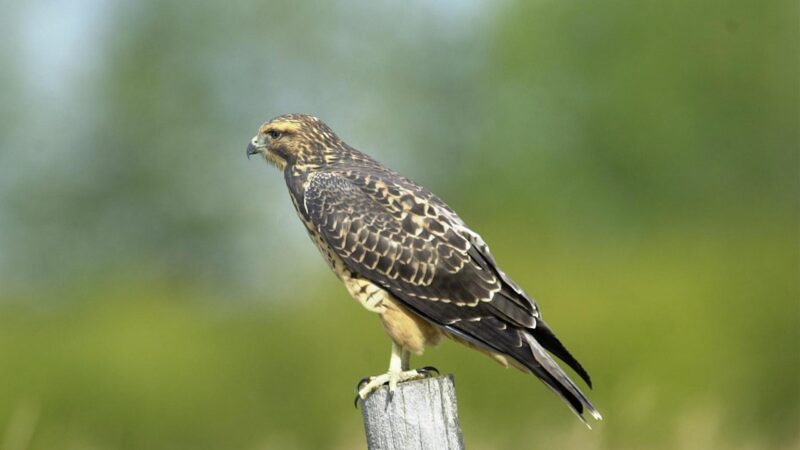
Named after their unusual feathered lower legs, which is a result of biological adaptation to their usually cold habitats, Rough-legged hawks are large raptors that are swift at hunting and can locate and capture prey with excellent precision.
- Scientific Name: Buteo lagopus
- Appearance: They have large bodies with broad but narrow wings, long tails, and small beaks.
- Color: Light morph adults have grayish backs and overall black bodies for males and brown backs for females with markings on the bellies and pale underwings for both sexes.
- Lifespan: 1.7 to 24 years (wild)
- Habitat: Open country areas in the arctic, agricultural lands, early successional areas, forested taiga, inland, and coastal alpine regions
- Length: 46 to 59 centimeters
- Weight: 745 grams to 1.38 kilograms
- Wingspan: 122 to 143 centimeters
- Diet: Shrews, squirrels, hares, mice, voles, small birds, carrio
- Place Of Origin: North America and Canada
- Characteristics: They are diurnal, territorial, and solitary birds but will migrate in small groups.
Swainson’s Hawk
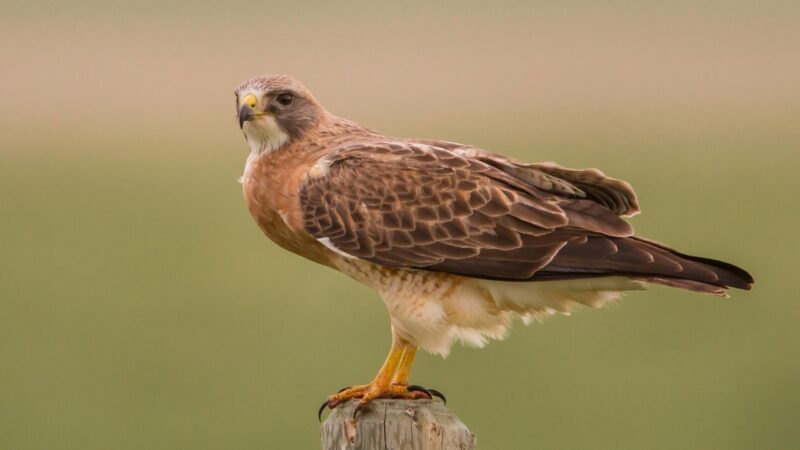
Despite being raptors, Swainson’s hawks are gentle creatures that can live harmoniously even with other birds in their nesting territories. They resemble miniature eagles and are often seen in vast flocks when migrating.
- Scientific Name: Buteo swainsoni
- Appearance: They have large-sized bodies with pointed wings and hooked beaks.
- Color: Light color morphs have dark brown plumage with white patches on the belly, forehead, and throat, while dark color morphs also have dark brown plumage, but a white patch is only found under the tail.
- Lifespan: Up to 19.5 years (wild)
- Habitat: Desert areas, agricultural areas, and open grasslands
- Length: 46 to 56 centimeters
- Weight: Up to 980 grams
- Wingspan: 122 to 132 centimeters
- Diet: Insects (primarily grasshoppers and crickets), birds, small mammals
- Place Of Origin: Western North America
- Characteristics: They are migratory birds that are usually gentle compared to other hawks but get highly territorial during mating season.
Broad Winged Hawk
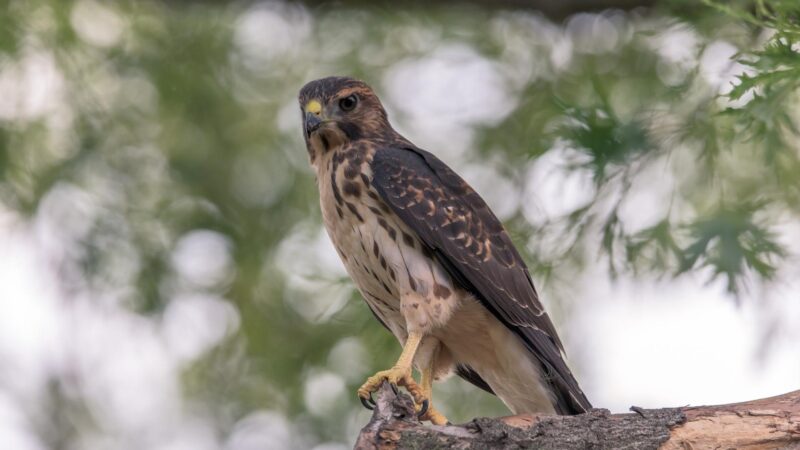
Aloof species during nesting season, Broad-Winged hawks have a distinct call which is considered a high and thin whistle. They’re excellent soarers, like other hawk species, and they like to spend most of their time under forest canopies while hunting.
- Scientific Name: Buteo platypterus
- Appearance: Small (males) to medium-sized (females) birds with stout bodies and short tails.
- Color: Reddish brown heads and chest, brown backs, tails are banded with black and white colors, underparts have barred patterns, and wings are pale in color and bordered in dark brown.
- Lifespan: 12 to 18.3 years (wild)
- Habitat: Large forests (deciduous, mixed, coniferous), arid tropical scrubs, groves, hardwood stands, forested uplands
- Length: 34 to 44 centimeters
- Weight: 265 to 560 grams
- Wingspan: 81 to 100 centimeters
- Diet: Small mammals (shrews, voles, chipmunks), insects, frogs, lizards, snakes, crabs, small birds (mostly juveniles and nestlings)
- Place Of Origin: Eastern United States and Southern Canada
- Characteristics: Diurnal, territorial, and solitary hawks except during the migrating season in which they migrate in flocks (referred to as “kettles”) that can equate to as many as thousands of individuals.
Sharp-Shinned Hawk

Considered the smallest hawks in North America, Sharp-Shinned hawks are acrobatic and fast fliers. They’re usually silent but are known to vocalize during breeding seasons and are also notorious for approaching bird feeders, not to eat bird feed but to prey on small birds that do.
- Scientific Name: Accipiter striatus
- Appearance: Small birds with distinct proportions as they have long legs, long square-tipped tails, and short rounded wings.
- Color: Bluish gray upper parts with darker-colored crowns, white underparts that are barred with brown, and wings are a dark to the light gradient.
- Lifespan: 3 to 19.9 years (wild)
- Habitat: Forest and forest edges that are dense and ideally with closed canopies. They’re also found in suburban and agricultural areas, particularly where bird feeders are.
- Length: 24 to 34 centimeters
- Weight: 87 to 218 grams
- Wingspan: 53 to 65 centimeters
- Diet: Primarily small birds (perching birds, shorebirds, doves, pigeons, swifts, hummingbirds, woodpeckers), small mammals, and large insects
- Place Of Origin: United States and Canada
- Characteristics: Territorial, and solitary, except during breeding and migrating seasons where they can be seen in small flocks.
Northern Goshawk

Named after the raptor’s habit of preying on other birds, Northern Goshawks are wilder and fiercer Accipiter species that often prowl through backyards and suburban areas. They hunt stealthily by maneuvering below canopies to hide from prey before striking them unsuspectingly.
- Scientific Name: Accipiter gentilis
- Appearance: They have large and bulky hawks with broad rounded wings and long tails.
- Color: Dark slate gray bodies with pale gray underparts that have a barred pattern, dark white-striped heads, and distinct white feathers above the eye.
- Lifespan: 10.7 months to 19.8 years
- Habitat: Montane and boreal forested habitats, preferably in coniferous and deciduous forests
- Length: 55 to 61 centimeters
- Weight: 631 grams to 1.37 kilograms
- Wingspan: 98 to 115 centimeters
- Diet: Primarily birds (crows, woodpeckers, bluejays), small mammals (squirrels, jackrabbits, cottontails), insects, reptiles, and occasionally carrion
- Place Of Origin: North America and Eurasia
- Characteristics: Highly territorial and sedentary, preferring to occupy their nesting areas for the rest of their lives, but some are known to migrate.
Red-Shouldered Hawk
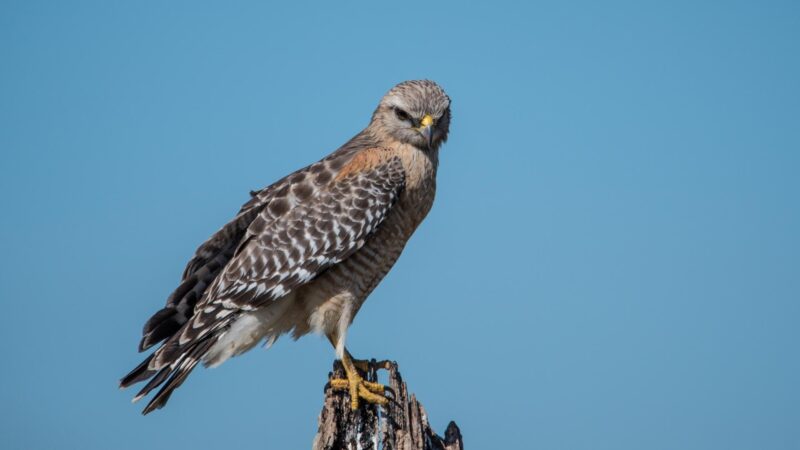
A forest-dwelling raptor that’s often seen soaring the skies and screeching loudly—making it the most vocal American hawk. Red-shouldered hawks adopt a perch-and-swoop strategy when hunting and are known to occupy the same habitats as Barred Owls.
- Scientific Name: Buteo lineatus
- Appearance: They are medium-sized hawks with broad, rounded wings, long legs, and tails that are medium-length.
- Color: Underparts are reddish and streaked with dark brown, backs and heads are brown, plumage is streaked with dark and white checkers, and tails are black with white bands.
- Lifespan: 25.6 months to 20 years (wild)
- Habitat: Forests that are the bottomland hardwood type or upland mixed deciduous-conifer type. They also live in forested swamps and are found in suburban areas near woodlands.
- Length: 43 to 61 centimeters
- Weight: 550 to 700 grams
- Wingspan: 92 to 107 centimeters
- Diet: Small mammals such as squirrels and rabbits, crayfish, snakes, lizards, frogs, and occasionally birds such as doves and sparrows.
- Place Of Origin: Eastern North America and Southern Canada
- Characteristics: Territorial and highly solitary as they don’t form flocks, even in the winter season. Most of these hawks are sedentary but a portion of their population is migratory.
Red-Tailed Hawk
This hawk is one of the most commonly seen species in North America. Red-tailed Hawks can be found soaring above fields when you’re on a long car ride, perching on top of telephone poles or fenceposts, or just simply flying across the sky, especially when migrating during the winter.
- Scientific Name: Buteo jamaicensis
- Appearance: They are large-sized hawks with broad, rounded wings and short, wide tails.
- Color: Bodies can be varying shades of brown, underparts are lighter than the color of their bodies with dark bands across them, tails are cinnamon red with a pale end, and legs and feet are yellow.
- Lifespan: Up to 29.5 years (wild)
- Habitat: Almost any type of open habitat including grasslands, woodlands, tropical rainforests, fields and pastures, deserts, parks, agricultural fields, and elevated perches.
- Length: 45 to 65 centimeters
- Weight: 795 grams to 1.46 kilograms
- Wingspan: 114 to 133 centimeters
- Diet: Primarily rodents such as mice and wood rats, small mammals such as cottontail rabbits, snowshoe hares, and squirrels, and birds such as starlings, bobwhites, and blackbirds. Occasionally snakes and carrion.
- Place Of Origin: Northern America and Canada
- Characteristics: They are diurnal and highly territorial hawks that remain in pairs for years in the same territory.
Ferruginous Hawk

Ferruginous hawks have unique feathered legs, a characteristic they share with Rough-legged hawks. They’re considered the largest North American hawk and can be found in the open country where they’re either soaring in the sky, perched on telephone poles, or the ground.
- Scientific Name: Buteo regalis
- Appearance: They are large hawks with large heads and broad, long pointed wings.
- Color: Predominantly rust color on backs, shoulders, and legs. Underparts are white and spotted with pale brown. The wingtips and tail are gray-colored.
- Lifespan: Up to 23 years (wild)
- Habitat: Grasslands, shrublands, sagebrush country, pinyon-juniper forest edges, desert edges, agricultural lands
- Length: 50 to 69 centimeters
- Weight: 980 grams to 2.03 kilograms
- Wingspan: 134 to 152 centimeters
- Diet: Small mammals such as hares, rabbits, prairie dogs, squirrels, and pocket gophers. Occasionally amphibians, birds, reptiles, and insects.
- Place Of Origin: North America
- Characteristics: They are migratory hawks, but only travel short distances during winter and solitary except during breeding seasons.
Frequently Asked Questions
Is It Illegal to Shoot a Red-Tailed Hawk in Indiana?
It is illegal to shoot a red-tailed hawk in Indiana. All hawks, regardless of species, are protected by the state and federal laws against killing, capture, or possession without a special permit and guidance of the U.S. Department of Agriculture’s Wildlife Services Agency.
What Is the Biggest Hawk in Indiana?
Ferruginous hawks are the largest hawks in Indiana, with a length of up to 69 centimeters and a wingspan length of up to 152 centimeters.
Why Are Hawks Hanging around My House?
Hawks are attracted to bird feeders, either to eat bird feed or to prey on other birds that land on them.
They’re also mostly opportunistic feeders, and if you have any livestock and poultry out in your yard or lawn, they will most likely hang around your house by perching in nearby trees and waiting for the right moment to swoop in for the kill.
Indiana has a total of 10 species of hawks, with ferruginous hawks being the largest. Killing, capturing, or possessing hawks without a special permit and guidance of the USDA Wildlife Services Agency is considered illegal in the state.
You can identify hawks by their subgroups: accipiters which have short, rounded wings and long tails, and buteos which are high soarers and have broad, banded, and round wings.
List of Sources
Limas, B. (2001). Circus cyaneus. Animal Diversity Web.
Good, G. (2008). Buteo lagopus. Animal Diversity Web.
Stabler, K. (2000). Buteo swainsoni. Animal Diversity Web.
Broad-winged Hawk, Buteo platypterus. Tennessee Wildlife Resources Agency.
Cooper’s Hawk, Accipiter cooperii. Tennessee Wildlife Resources Agency.
